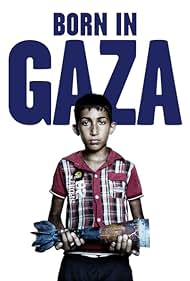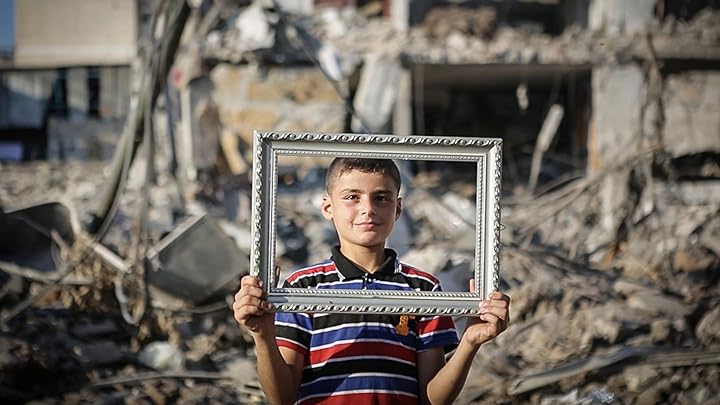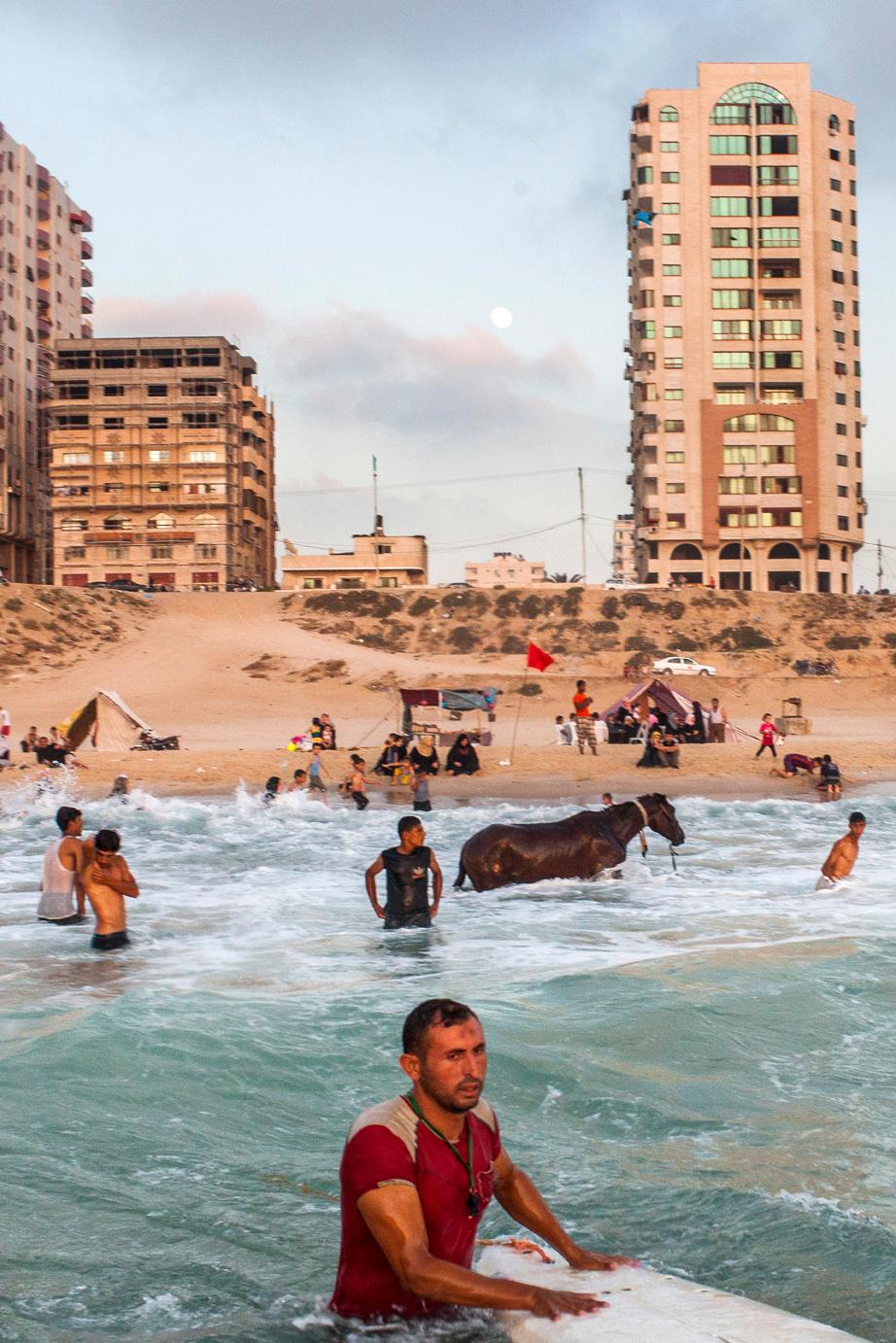 Two documentaries made before the current conflict, giving an inside view of life in Gaza from the perspective of its inhabitants: Born in Gaza (dir. Hernan Zin, 2014) and Gaza (dirs. Andrew McConnell and Gary Keane, 2018).
Two documentaries made before the current conflict, giving an inside view of life in Gaza from the perspective of its inhabitants: Born in Gaza (dir. Hernan Zin, 2014) and Gaza (dirs. Andrew McConnell and Gary Keane, 2018).
As I write in early December 2023, hostilities have just resumed in Gaza. The current wave of conflict was undoubtedly provoked by Hamas, but there is obviously a much longer history here. Israel has occupied Gaza since 1967, and has effectively blockaded the region for decades. Media coverage of the events since 7th October has been relentless; but amid the hours of current affairs journalism and political commentary, there has been little sense of what this conflict has meant for the people who live there.
At least in the UK, much of the media coverage right now is focusing on the experiences of the Israeli hostages. Thus far this year, 37 Israeli children have been killed; yet the number of Palestinian children is at least one hundred times as many. Of course, the statistics are endlessly disputed: especially today, every war is also a war of information. But the statistics – like the wall-to-wall reports of bombings and atrocities – also provide little insight into the realities of life for ordinary people in Gaza.
 In this piece, I want to look at two award-winning documentaries that have sought to achieve this. Both were made before the current conflict. In my view, they are now essential viewing.
In this piece, I want to look at two award-winning documentaries that have sought to achieve this. Both were made before the current conflict. In my view, they are now essential viewing.
Born in Gaza
Born in Gaza was made in 2014, in the wake of an earlier conflict in the ongoing war in Gaza. It was made in Spain for Canal+ and directed by the Italian-Argentinian Hernan Zin. It is currently available on Netflix.
The film was shot in 2014, in the aftermath of an outburst of fighting in which 550 Palestinian children were killed, as against two Israelis. It follows ten individual children. We meet Mohamed, who lives in a refugee camp and is now the only breadwinner in his family: he lives by collecting plastic debris from the rubbish dump. We meet Udai, who has seen his brother blown to pieces, sifting through the rubble of a collapsed building; Mahmud, whose father’s farm near the border has been destroyed by Israeli diggers and bombs; Rajaf, whose father was working as an ambulance driver when he was killed in the conflict; and Malak, whose United Nations school was bombed, killing 22 and injuring 80. We also meet a group of four boys, including Hamada and Mofasem, who were playing football on the beach with four other friends, when they were killed by an Israeli missile (and in this case, their story appears to be corroborated by news footage).
 The film introduces the children one by one, and the first part concludes with the names of children killed in the conflict gradually filling a black screen. A caption informs us that 70% of the children who were killed in 2014 were aged under twelve. Then in the last 20 minutes or so, the film loops back to encounter the same children again three months later, as they attempt to come to terms with what has happened. Hamada, the oldest of the beach footballers, points out where his dead siblings used to sleep, and talks about how Mofasem is haunted by seeing his younger brother’s spirit. Bisan, whose face has been disfigured by a bomb, attends the hospital to have her dressings changed. Udai revisits his bombed-out home, showing where he and his brother used to sleep: he says that the Israelis refuse to allow them to bring materials to rebuild, and the family is now living on the street. Several of the children say they can no longer sleep and have been ‘driven crazy’ by the war. Rajaf gazes endlessly at his father’s picture, and tells his mother that he wants to die. Some make appeals for psychological support: as Hamad puts it, ‘we need to be taken abroad for help, so we can forget what happened’.
The film introduces the children one by one, and the first part concludes with the names of children killed in the conflict gradually filling a black screen. A caption informs us that 70% of the children who were killed in 2014 were aged under twelve. Then in the last 20 minutes or so, the film loops back to encounter the same children again three months later, as they attempt to come to terms with what has happened. Hamada, the oldest of the beach footballers, points out where his dead siblings used to sleep, and talks about how Mofasem is haunted by seeing his younger brother’s spirit. Bisan, whose face has been disfigured by a bomb, attends the hospital to have her dressings changed. Udai revisits his bombed-out home, showing where he and his brother used to sleep: he says that the Israelis refuse to allow them to bring materials to rebuild, and the family is now living on the street. Several of the children say they can no longer sleep and have been ‘driven crazy’ by the war. Rajaf gazes endlessly at his father’s picture, and tells his mother that he wants to die. Some make appeals for psychological support: as Hamad puts it, ‘we need to be taken abroad for help, so we can forget what happened’.
The film ends with shots of the sea – a recurring motif in both films. Mohamed walks into the waves and swims out: ‘I love the sea,’ he tells us. ‘I was born by the sea. I would love to be in the sea all my life, living and swimming in it.’ Despite the Israeli exclusion zone that confines Palestinian fishing boats to a three-mile radius (and to the least plentiful waters), the sea functions as an obvious symbol of a freedom that is denied.
Gaza
The second film, simply called Gaza, is an Irish/Canadian co-production supported by a consortium of European public broadcasters. Shot in 2018 and released in 2019, it was directed by Gary Keane and Andrew McConnell. It is currently available on Amazon Prime.
If you were seeking some more detailed indication of what people mean when they describe Gaza as an open-air prison camp, this would be it. Like Made in Gaza, the film introduces us to a group of participants one by one. We meet 14-year-old Ahmad Jamal Bakr, one of a very large family living in an overcrowded shelter in a refugee camp, who dreams of becoming the captain of a fishing boat; Karma, a middle-class teenager who is learning to play the cello and aspires to win a scholarship to an international university; and Mahmoud, a young man who has seen too many of his friends killed and injured, and has given up a career in photography to become a lifeguard. We meet an aspiring rapper, now paralysed and wheelchair-bound after being repeatedly shot in the second Intifada. Among the adults, we meet a tailor who has been forced to sell his larger factory in favour of a small workshop that is plagued by power cuts; a taxi driver who ferries many of the participants around, keeping them entertained by joking and singing; a theatre director who performs an emotive one-man show; and a doctor working for the Red Crescent, who attends to young men shot by the Israelis while throwing stones across the border.
 Along the way, we learn some key facts about the situation in Gaza at this time: the lack of reliable water and power supplies; the Israeli blockade of the sea, which means that the fishing industry has been decimated; the high levels of unemployment (45%); and the lack of sufficient food and drinkable water. ‘There are days when we only eat salt,’ says Ahmed, as he works repairing the fishing nets. Even the cheerful taxi driver has spent time in prison, along with many other business people, unable to cope with his debts. ‘How can people survive?’ asks the tailor. ‘We lack our main sources of living. The dead are better off than the people living in the Gaza Strip.’
Along the way, we learn some key facts about the situation in Gaza at this time: the lack of reliable water and power supplies; the Israeli blockade of the sea, which means that the fishing industry has been decimated; the high levels of unemployment (45%); and the lack of sufficient food and drinkable water. ‘There are days when we only eat salt,’ says Ahmed, as he works repairing the fishing nets. Even the cheerful taxi driver has spent time in prison, along with many other business people, unable to cope with his debts. ‘How can people survive?’ asks the tailor. ‘We lack our main sources of living. The dead are better off than the people living in the Gaza Strip.’
And yet, amid the gloom, there are also moments of joy: friends laugh and embrace each other, children play about on the beach and in the sea, there is music and dancing, theatre and even a fashion show. However briefly, people are able to forget about the conflict. Once again, for many the sea serves as a source of solace: ‘being by the sea comforts me,’ Karma says, ‘it gives me a sense of freedom’.
As in Born in Gaza, the film introduces its key participants and then goes back to cycle through them once more. For about the first hour, there is a general sense of people surviving despite adversity, often with good humour and even some passing optimism. However, after a short lyrical interlude, the film then builds to a more violent climax. Amid an Israeli bombardment, ambulances rush back and forth, bodies are pulled from collapsed buildings, children are injured and mothers scream and howl in despair. We learn that four children from the Bakr family (who are living in the refugee camp) have been killed. As the sound fades, a stream of refugees walks across the screen, cut into shots of ruined cars and men weeping amid the rubble. People kneel to pray in a ruined building. We are told that 66 Israeli soldiers have been killed, and five hundred Palestinian children.
The film ends on a portentous note. In what is surely a staged shot, we see Karma playing her cello on abandoned ground next to a bombed-out house, with the sea in the background. ‘Four years have passed since the last war, and we see another one looming,’ she says. ‘We are stuck in this never-ending cycle of conflict. We are forced to relive this torture over and over again. When will it end?’ In the closing shots, we see one of the boys determinedly rowing out to sea.
Just propaganda?
These films are self-evidently only telling one ‘side’ of the story – although it might well be argued that we hear a great deal more about the other side in the mainstream media, and that Palestinian causalities vastly outnumber Israeli ones. Both films – perhaps particularly Born in Gaza – might be accused of milking the suffering, for example in their use of melancholy music and slow-motion photography. Equally, the concluding scenes of Gaza certainly play up the horror, bringing the film to an angry and almost devastating climax. We see virtually nothing of Hamas. Yet it’s possible to recognise the choreography of all this while still finding it hard to watch: I don’t often cry over a documentary.
 Predictably, and very sadly, both films have been dismissed by Israeli supporters as ‘antisemitic’. Reviewers on Netflix accuse Born in Gaza of being equivalent to Nazi propaganda: they suggest that sequences have been faked, and that the film is simply ‘lying’. Similar charges have been laid, although less vehemently, against the other film.
Predictably, and very sadly, both films have been dismissed by Israeli supporters as ‘antisemitic’. Reviewers on Netflix accuse Born in Gaza of being equivalent to Nazi propaganda: they suggest that sequences have been faked, and that the film is simply ‘lying’. Similar charges have been laid, although less vehemently, against the other film.
To be sure, there is no pretence of neutrality in either film – although it’s hard to imagine how such neutrality might be achieved. Both films purport to be observational, to capture the texture of everyday life. There is no ‘voice of God’ commentary, and captions are limited and functional: the only voices we hear are those of the participants themselves. Of course, there is selection and editing at work; but the primary aim is to follow ordinary people trying to go about their lives, rather than offering any broader political analysis. Nobody talks about race or religion. There are occasional observations about politics in Gaza, but they could hardly be construed as being in favour of Hamas. The tailor, for example, is pessimistic about the possibility of any reconciliation; but ‘if we didn’t have Hamas,’ he argues,’ the entire Palestinian issue would be resolved’. Likewise, in one of the rare political comments in Born in Gaza, Hamada, one of the beach footballers, says that Fatah, Hamas and the government of Ramallah have failed to help the victims, despite their promises. Yet ultimately, these are films about the human effects of war and occupation: they are not bids in a tit-for-tat argument about politics.
Both films do undeniably take a side. However, this is not so much a political position as one that stands in opposition to war and in support of freedom. ‘We want to be independent,’ says the patriarch of the Bakr family. ‘We want to be free like the rest of the world. We don’t want sixty more years of occupation.’ Or as the ambulance driver puts it, even more simply: ‘we want to live, that’s it. That’s what people need to know. We don’t want to be killed or injured. We simply want to live!’
As I watched these films, I did wonder how many of the people they feature are now dead – and how many of the young people in particular will have joined up to Hamas. While some of the children hope to become doctors or academics, or just fishermen like their parents, one at least (in Born in Gaza) expresses the wish to ‘join the resistance and make justice’ for his family. As the ambulance driver in Gaza puts it, ‘for ten years now, these young men have had no hope, no future. They have become a burden to society. Young men are ruined, and as a result, Palestinian society is being destroyed and torn apart.’
The idea that Palestinian opposition to the Israeli occupation can simply be ‘eradicated’, as Netanyahu believes, is surely a fantasy – especially when there are powerful international interests prepared to fund it. A humanitarian response is certainly required, although it will only address the consequences rather than the causes of the conflict. In the meanwhile, it would be a start if we could learn to see the victims of this conflict as human beings, rather than as statistics or as some kind of military collateral.
